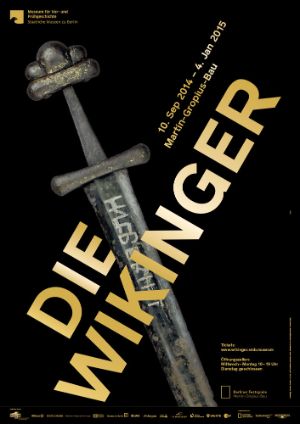Exhibition
The Vikings

Exhibition poster “The Vikings”. Ulfberht swordt, 10th century A.D. © Staatliche Museen zu Berlin, Museum für Vor- und Frühgeschichte / Claudia Plamp
Warriors and conquerors, sailors, traders, farmers and highly specialized craftspeople: from the ninth to eleventh century the Vikings dominated the North and Baltic Seas. They travelled from Russia up to the Byzantine Empire, established settlements on the coasts of Greenland and North America. The centrepiece of the exhibition is the largest surviving Viking warship with a length of 37 metres.
The Berlin exhibition centres around the restored Danish longship, Roskilde 6, which is on display for the first time. The huge vessel takes up the whole of the large atrium of the Martin-Gropius-Bau. At 37 metres long, it is the largest Viking ship so far discovered, and it forms the focal point of the exhibition. It was built around 1025 for use as a warship and was rediscovered in the harbour area of the town of Roskilde in 1996/97. A section of the hull and the entire 32 metre-long keel of the vessel have survived. After meticulous conservation lasting from 1997 to 2012, the original timbers are now embedded in a specially made steel framework which recreates the shape and original dimensions of the ship.
In the exhibition, “The Vikings”, the great museums of three of Europe’s cultural capitals – Copenhagen’s National Museum of Denmark, London’s British Museum and Berlin’s Museum of Prehistory and Early History – set out in search of a people shrouded in myth: the Norsemen. Although many of the exhibits are displayed in all three locations, each stage of the exhibition nevertheless has a unique character of its own.
Organizer: Museum für Vor- und Frühgeschichte – Staatliche Museen zu Berlin, in cooperation with the National Museum of Denmark, Copenhagen and the British Museum, London